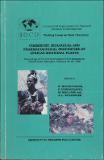| dc.contributor.author | Cragg, G.M. | |
| dc.contributor.author | Boyd, M.R. | |
| dc.contributor.author | Christini, M.A. | |
| dc.contributor.author | Mays, T.D. | |
| dc.contributor.author | Mazan, K.D. | |
| dc.contributor.author | Sausville, E.A. | |
| dc.coverage.spatial | United States | en |
| dc.date.accessioned | 2016-03-21T11:58:36Z | |
| dc.date.available | 2016-03-21T11:58:36Z | |
| dc.date.issued | 1996-02-25 | |
| dc.identifier.citation | Cragg, G.M. et al., (1996) International collaboration in drug discovery and development. The United States National Cancer Institute experience. In: Hostettmann, K., Chinyanganya, F., Maillard, M. and Wolfender, J.-L. (eds.) Chemistry, biological and pharmacological properties of African medicinal plants: proceedings of the first International IOCD-Symposium, Victoria Falls, Zimbabwe, February 25-28 1996. Harare: UZ Publications, pp. 43-69. | en |
| dc.identifier.uri | https://opendocs.ids.ac.uk/opendocs/handle/20.500.12413/10177 | |
| dc.description | A research paper on international collaboration in drug discovery and development. | en |
| dc.description.abstract | In 1937, the United States National Cancer Institute (NCI) was established with its mission being "to provide for, foster and aid in coordinating research related to cancer". The NCI is the largest of seventeen Institutes which comprise the National Institutes of Health (NIH), which are components of the Federal Government's Department of Health and Human Services. The NCI and NIH are entirely funded through appropriations from the U.S. Congress and, as such, are entirely non-commercial and non-profit. Thus, while the NCI will attempt to license drugs discovered through its screening programs to pharmaceutical companies for advanced development and marketing, chemotherapeutic agents not licensed, but considered by NCI to be clinically effective, will be distributed by the NCI at no cost to the patients. An example is the antileukemic agent, Erwinia L-asparaginase, which was procured by the NCI and distributed free of charge until its production and marketing were transferred to the private sector.
In 1955, NCI set up the Cancer Chemotherapy National Service Center (CCNSC) to promote a cancer chemotherapy program, involving the procurement, screening, preclinical development, and clinical evaluation of new agents. All aspects of drug discovery and preclinical development are now the responsibility of the Developmental Therapeutics Program (DTP), a major component of the Division of Cancer Treatment, Diagnosis and Centers (DCTDC). During the past 40 years, over 300,000 chemicals submitted by investigators and organizations worldwide, have been screened for antitumor activity, and NCI has played a major role in the discovery and development of almost all of the available commercial and investigational anticancer agents (Boyd 1993). | en |
| dc.language.iso | en | en |
| dc.publisher | University of Zimbabwe (UZ) Publications. | en |
| dc.rights.uri | http://creativecommons.org/licenses/by-nc-nd/3.0/ | en |
| dc.subject | Development Policy | en |
| dc.subject | Health | en |
| dc.subject | Science and Society | en |
| dc.title | International collaboration in drug discovery and development. The United States National Cancer Institute experience | en |
| dc.type | Book chapter | en |
| dc.rights.holder | University of Zimbabwe (UZ) | en |


